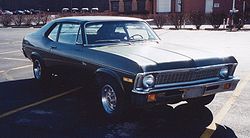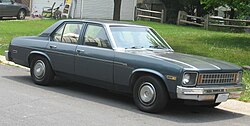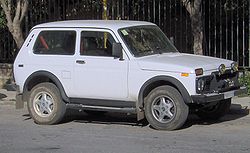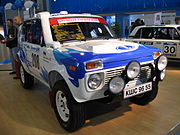Chevrolet Nova
The Chevrolet Nova or Chevy II was an American compact car introduced by the Chevrolet division of General Motors in 1962. The original Chevy II was of unibody construction, powered by an OHV inline-four or 6-cylinder engine, and available in two-door and four-door sedan configurations as well as convertible and station wagon versions. After the rear-engine Chevrolet Corvair was handily outsold by the conventional Ford Falcon in 1960, Chevrolet began work on a more conventional compact car that would eventually become the Chevy II. These cars were also sold in Canada from 1962 as the Pontiac Acadian (GM Canada nameplate), with minimal trim and equipment modifications, until the early 1970s when they were renamed in keeping with their US cousins as the Pontiac Ventura II.
Generations
First generation (1962–1967)

1963 Pontiac Acadian Beaumont convertible
Available engines for the Chevy II included a 153 in³ four-cylinder and a 194 in³ inline six. The six-cylinder was actually the third generation engine, replacing the second generation Stovebolt. Rival manufacturer Chrysler had earlier developed the Slant Six in their Plymouth Valiant, a Chevy II competitor, when the cars were introduced to the public in late 1959 as 1960 models.
Although the Nova was not originally available with a V8 option, the engine bay was perfectly proportioned for one. It wasn't long before Chevrolet V8s were offered as dealer-installed options (between 1962 and 1963), up to and including the fuel injected version available in the Corvette. The combination of readily available V8 power and light weight made the Nova a popular choice of drag racers.
In 1962 and 1963 the Nova was available in a convertible body style, and a two-door hardtop was available from 1962 to 1965, although the hardtop was dropped when the '64 models were first introduced, and subsequently brought back to the line later in the model year. Like all Chevy two door hardtops, the body style was marketed as the Sport Coupe.
For 1963, the Chevy II Nova Super Sport was released. As mentioned above, Novas could not "officially" have V8 engines at this time — the standard SS engine was the six-cylinder — but small-block V8 engine swaps were commonplace among enthusiasts. For 1964, the Chevy II's first factory V8 option was introduced, which was a 195 hp (145 kW) 283 in³ V8. In 1965, a 327 in³ V8 was also available with up to 300 hp (220 kW).
(1966–1967)
1966 Novas saw a significant restyling, based in part on the Super Nova concept car. In general, proportions were squared up but dimensions and features changed little. Engine options still included the basic inline four and six-cylinder engines and V8s of 283 and 327 in³ (4.6 and 5.4 L), the latter offering now offering up to 350 hp (261 kW).
During this time, the 90 hp (67 kW) 153 in³ four-cylinder engine was only offered in the base Chevy II 100 series models with the 120 hp (89 kW) 194 in³ inline-six standard on the Nova and Super Sport models. In addition to the V8s, other optional engines included a 140 hp (104 kW) 230 in³ six-cylinder and a 155 hp (116 kW) 250 in³ six-cylinder, the latter a new offering for 1967. For 1966, Super Sport (SS) models did not carry the Nova name, but were badged as Chevy II Super Sports.
Although Chevy IIs had the same body for both these years, 1967 models carried significant improvements in the area of safety equipment. A government-mandated energy-absoring steering column and safety steering wheel, soft interior parts such as armrests and sun visors, recessed instrument panel knobs, and front shoulder belt anchors, were included in all 1967 models.
Second generation (1968–1974)
An extensive restyle came in 1968, when the station wagon and Sport Coupe were discontinued. This body style continued (with minor revisions) through 1974. One notable change was the front subframe assembly — as compared with Ford, Chrysler and AMC, in whose cars the entire front suspension was integrated with the bodyshell, a separate subframe housing the powertrain and front suspension (similar to the front part of the frame of GM's full-size, full-framed vehicles) replaced the earlier style. Although the front subframe design was a Chevy II-exclusive design, the Camaro introduced a year earlier was the first to incorporate such a design; the redesigned Chevy II was pushed a year back to 1968 instead of 1967. 1968 was the final year that the Chevy II nameplate was used, although all 1968 models were "Chevy II Novas" with one single trim line.
The 153 in³ four-cylinder engine was offered between 1968 and 1970, then was dropped due to lack of interest (besides its other usage in the Jeep DJ-5A a.k.a. the Postal Jeep). Far more popular were the 250 in³ six-cylinder and the base 307 in³ V8, which replaced the 283 in³ V8 offered in previous years. At mid-year, a semi-automatic transmission based on the Powerglide called the Torque-Drive was introduced as a low-cost option for shiftless motoring for both the four and six-cylinder engines. The two-speed Powerglide was still the only fully-automatic transmission available with most engines as the more desirable three-speed Turbo-Hydramatic was only available with the largest V8 engines.
The SS was transformed from a trim package to a performance option for 1968 and now included a 295 hp (220 kW) 350 in³ V8 engine along with front disc brakes, heavy-duty suspension and other performance hardware. Optional engines included two versions of the big-block 396 in³ V8 rated at 350 and 375 hp (280 kW). Both engines were offered with a choice of transmissions including the M-21 close-ratio four-speed manual, the M-22 heavy-duty "Rock Crusher" four-speed manual, or the three-speed Turbo-Hydramatic 400 for those who preferred automatic shifting.
1969
For 1969, the Chevy II nameplate was retired and the car became the "Chevrolet Nova" for this year (some sources referred to it as the Chevrolet Chevy Nova - perhaps the decision to drop the Chevy II moniker was a last-minute decision for 1969). No Chevy nameplates remained for 1969. The trunklid badge "Chevy II by Chevrolet" was replaced by "Nova by Chevrolet" Like other 1969 GM vehicles, locking steering columns were incorporated. Simulated vents were added below the Nova script, which was relocated to the front fender instead of the rear quarter panel. The 350 in³ V8 with four-barrel carburetor that came standard with the SS option was revised with a 5 hp (4 kW) increase to 300 hp (220 kW) while a two-barrel carbureted version of the 350 in³ V8 rated at 255 hp (190 kW) was a new option on non-SS models. A new Turbo-Hydramatic 350 three-speed automatic was made available for non-SS Novas with six-cylinder and V8 engines, although the older two-speed Powerglide continued to be available on the smaller engined Novas.
1970
Basically a carryover from 1969; the side markers and taillight lenses for the 1970 Nova were wider and positioned slightly differently. This was the final year for the SS396. All other engines were carried over including the seldom-ordered four-cylinder which was in its final year. The car finally became simply the Chevrolet Nova this year after two years of transitional nameplates (Chevy II Nova in 1968 and Chevrolet Chevy Nova in 1969) Approximately 177 COPO Novas were ordered, with 175 converted by Yenko Chevrolet. The other two were sold in Canada.
1971
1971 Novas were similar to the previous year but with the loss of the simulated fender vents and the discontinuation of the 396 in³ engine for the SS with the 350 in³ engine taking its place. 1971 also saw the introduction of the Rally Nova, a trim level that only lasted two years (until it resurfaced in 1977). The Rally kit included black or white stripes that ran the length of the car and around the back, a Rally Nova sticker on the driver's side of the hood, and Rally wheels.
The 250 in³ six-cylinder engine was now the standard Nova engine with the demise of the 153 in³ four-cylinder and 230 in³ six-cylinder engines. The 307 in³ and 350 in³ V8s were carried over from 1970 and all engines featured lowered compression ratios to enable the use of unleaded gasoline as a result of a GM corporate mandate that took effect with the 1971 model year.
After 1971, other GM divisions began rebadging the Nova as their new entry-level vehicle, such as the Pontiac Ventura II (once a trim option for full-size Pontiacs to 1970), Oldsmobile Omega and the Buick Apollo. Interestingly, the initials of the four model names spelled out the acronym NOVA (Nova, Omega, Ventura, Apollo).
1972
A virtual rerun of 1971, the 1972 Nova received only minor trim changes and both the Rally Nova and SS options were carried over. At mid-year a sunroof option became available on two-door models. Also, the optional Strato bucket seats available on coupes switched from the previous low-back design with adjustable headrests to the high back units with built-in headrests introduced the previous year on Camaros and Vegas. Shoulder belts now attached to the lap belt tongue with a pin-and-keyhole type attachment, this unit then attached to the inboard buckle for each outboard front occupant. This arrangement eliminated the separate belts for lap and shoulders, and was used on all 1972 and 1973 GM (and other domestic) models.
1973-1974
The 1973 model year introduced a hatchback bodystyle based on the 2-door coupe. Following a government mandate for vehicles to be fitted with front and rear bumpers capable of absorbing a low-speed impact of 5 mph (8.0 km/h), the front and rear of the Nova were restyled. The 1973 model was equipped with redesigned bumpers that were larger and stronger. 1974 models were the first to have shock-absorbing bumper mounts that made the bumpers stick out further from the body.
A modified rear side window shape was also introduced, eliminating the vent windows on both two- and four-door models. A revised rear suspension was adapted from the second generation Camaro with multi-leaf springs replacing the mono-leaf springs used on Novas since the original 1962 model. By this time, six-cylinder and V8 engines were de rigueur for American compact cars, with the 307 in³ and 350 in³ (5.0 and 5.7 L) V8s becoming fairly common. Nova SS models offered a higher-performance 350 in³ V8. The 1973 Nova with a six-cylinder engine or 307 in³ V8 were among the last Chevrolets to be offered with the now-outdated two-speed Powerglide automatic transmission, which was in its final year. For 1974, it was replaced by a lightweight version of the three-speed Turbo-Hydramatic 350 already offered with the 350 in³ V8, which was the only V8 offered for 1974. These Novas where also fitted with a weight sensitive relay within the front bench seat that prevented the vehicle from being started until the driver's seatbelt had been fastened. Later, a law passed by Congress banned this type of device, declaring that it infringed on a driver's freedom of choice. [1] The devices were not included in future Nova models.
1973 and 1974 introduced several new technologies to the Nova such as the adoption of steel belted radials. Also, the hatchback Nova models used a compact spare tire that included an inflator can with the vehicle. While many of these cars were sold with four-wheel drum brakes, front disk brakes were available as an extra-cost option.
A luxury-themed Nova Custom, later called the Nova LN, became part of the model lineup which included upgraded upholstery, full carpeting and more exterior trim. The SS option was still available but became more of a sporty trim package than a performance offering and now offered with any Nova engine, much like the 1963 to 1967 Nova SS.
An interesting model was the 'Spirit of America' Nova introduced in 1974. In anticipation of the US bicentennial in 1976, these vehicles were painted white and featured blue and red accent stripes as well as red and blue interior carpets and fabrics.
Oldsmobile and Buick entered the compact car market; both the Apollo and Omega debuted, using the same bodystyles from the Nova lineup. Additional options were included on these Nova-like models, such as lighting under the dashboard and in the glove compartment. Pontiac's final GTO of this era was based on a facelifted 1974 Ventura coupe, itself based on the Nova, but fitted with a shaker hoodscoop from the Trans Am.
Third generation (1975–1979)
A completely restyled Nova was introduced in 1975 and continued through 1979. Base coupes, including the hatchback, had fixed side windows (or optional flip-out windows) and vertical vents on the B-pillar. This generation is sometimes called the "Disco Nova" due to the popularity of disco music during this era.
The base model carried the inline Six-cylinder 250 CID, 115 hp (86 kW), and couples V8 engines (305 and 350 CID) were offered. Mated to a three speed automatic, 3 speed manual or 4 speed - V8s only - Which remained the norm through the end of the decade (and the end of the rear-wheel drive X platform).
The front suspension and subframe assembly was similar to the one used in the second generation GM F-body cars (the Camaro and Pontiac Firebird), whereas the rear axle and suspension were carried over from the previous generation. All this made this car very solid but also heavy (1,600 kg empty and 2100 kg (4630 lb) curb weight)

1976 Chevrolet Nova coupe
The Nova lineup ranged from the stripped-down "S" model, base, Custom (1975 and 1978 to 1979, which in later years became the LN and Nova Concours replacement), and the luxury-themed LN (the LN was the first to sport metric displacement badges — either "4.3 LITRE" or "5.7 LITRE"). The LN was replaced with the Nova Concours (1976 and 1977; 1977 models had a 3-taillight lens scheme much similar to the Impala with a Cadillac-esque front clip). All were intended as competition for the recently introduced Dodge Aspen/Plymouth Volare and Ford Granada/Mercury Monarch. From 1977 to 1978, there was also the Nova Rally (not to be confused with the Rally Nova of the early 1970s). These came with the 135 hp (101 kW), 305 CID V8 engine, stiffer antiroll bar and some with the 4-speed Saginaw manual transmission.
Even Cadillac got into the act; the Nova's X platform was stretched by several inches, completely rebodied and fitted with an Oldsmobile fuel-injected 350 V8 to become the Seville for mid year 1975.
Buick's Apollo was renamed Buick Skylark after 1975 (during the 1975 model year, the Apollo nameplate was used for the 4-door sedan, while the coupe version was badged as the Skylark), while Pontiac's Ventura became the more luxurious Phoenix for 1978 (the Phoenix was the first X-body fitted with square headlights). These rebadged versions of the Nova had either the Chevrolet "porky but reliable" inline-six 250 CID or Buick V6 231 CID as the base engine.
In the 1977 model year minor changes were made for the Nova; round speedometer, straight dashboard. For 1978 model year Nova things remained almost the same, just minor changes like the steering wheel, some new colors were offered (as with the rest of the divisions) and some small trim added. During the 1977 model year of Ventura, the GM Iron Duke was the base engine (in response to the Arab Oil Embargo) coupled to a Borg-Warner T-50 transmission (it has no relationship to the T-5 found in third-generation GM F-bodies). The Ventura was replaced by the Phoenix in the middle of the 1977 model year.
Base V8 engines included Chevrolet 262 CID and 305 CID engines, and an Oldsmobile 260 CID V8; Pontiac Venturas were not fitted with a Pontiac V8 from the factory after 1975, when Oldsmobile 260s and Buick 350s were installed as optional equipment. This led to civil action against GM.
The Nova SS continued for 1975 and 1976; when the SS was discontinued, the option code for the SS — RPO Z26 — continued as the Nova Rally until 1979.
A high-performance police version of the Nova was introduced for the 1975 model year, making it the first compact car certified for police duty in the US. Most were initially purchased by the Los Angeles County Sheriff's Department in 1976.
Upon introduction of the downsized GM A-body (later G-body) mid-size cars in 1978, the X-body and downsized A-platform had similar exterior dimensions. The roomier and more modern downsized A-bodies outsold their X-body counterparts.
The Nova's final model year, 1979, saw few changes. The front end was revised with square headlights and a new grille for the short run. Production ended on December 22, 1978.
From model year 1980 onward, the Nova's original niche in the Chevrolet lineup was filled by front-wheel drive compacts including the Citation (spring 1979 to 1985), and Corsica (spring 1987 to 1996).
Fourth generation
The Chevrolet Nova nameplate returned in 1985 as a front wheel drive subcompact vehicle produced from 1985 to 1988. It was manufactured in Fremont, California by NUMMI, a joint venture between General Motors and Toyota of Japan. The new Nova was a rebadged and mildly restyled japanese market Toyota Sprinter, a model sold in Japan as an upmarket version of the Toyota Corolla. Nova shared the Corolla's AE82 platform, 1.6 liter 4-cylinder engines and was available with 5-speed manual, 3-speed or 4-speed automatic transmissions.
Novas abroad
Argentina
The early third-generation (1968 model) Nova was marketed in Argentina as the Chevrolet Chevy from late 1969 through 1978. An upscale model was produced from about 1973 with different trim, front turn indicators and taillights, a much better appointed interior with plastic "wood" trim, and called the Malibu. This Malibu was 100% a Chevy Nova, no relation to the American Chevelle. All engines provided to the public were inline-sixes. The first and second generations were available, depending on year and model, with the 194 cid and 230 cid engines. The third generation ("Chevys") were produced with the 230 cid and 250 cid engines. The "Chevy" metal decal for the third generation had the same font as the "Nova" decal of 1968-1974 American Novas, and was, for the first few years, in the rearmost section of both rear fenders. Later, it was moved to the rearmost section of both front fenders, as it was in the American cars from 1969. Sidemarker lights were not mandatory and changed much during the production run, from being deleted, to leaving a small chrome plate, to the same light as in the American cars. Rear deck decals just said "CHEVROLET" in chrome letters, obviating the typical "Model by Chevrolet" used in the American cars at the time. The hood decal was similar to the 1969 American Novas, the bow tie, in blue or just chrome. The first- and second-generation Novas were sold as the Chevrolet 400; the second-generation Nova was produced until 1974. Internally, the Argentinian Chevy used very similar trim to the American counterpart, usually being more luxurious, as the car fitted in a much higher market niche, being a "big" car for the local standards. Even then there were standard, plain models, without accesories. Many were used for cab service. Interesting to note is that the interior layout, especially visible in the instrument panel, remained the American 1968 version for the whole run. The ignition switch was never moved to the steering column, for instance, so no steering lock was installed in the factory. Power steering began to be available from the factory at the end of the production run, V8s were never produced for the car, and automatic transmissions were only available with steering column selectors, and not for all models, only for luxury versions. Power windows were not available, tinted windows were darker than American versions, and the darker band on the upper edge of the windshield was not present. Very popular accesories were vinyl roofs, rally wheels, sport steering wheels, bucket seats with high backs, and tufted leatherette upholstery (many sedans were produced this way). Interiors were mostly black. Steering wheels and instrument panels were for many years only black, as were seatbelts. American style interior color coordination was absent.
Their SS counterparts were both coupes and 4-door sedans, the latter of which was unheard of in the US prior to the introduction of the 1994 Impala SS. In fact, a majority were fitted with inline-sixes coupled to a ZF manual transmission with 4 speeds and a floor lever.
The urban legend
A popular urban legend asserts that the Nova sold poorly in Latin America because the phrase no va means "it doesn't go" in Spanish. In reality, if a Spanish-speaking person were to say that his car was not working, he would more likely use the terms no marcha or no funciona, ("does not run" or "does not work/function," respectively) instead, just as an English-speaking person would be more likely to say "this car doesn't work," than say "this car doesn't go." The word nova, as opposed to no va, exists in Spanish with the same meaning as in English. In addition, the Nova actually sold well, exceeding Chevrolet's expectations.

























![Validate my RSS feed [Valid RSS]](valid-rss-rogers.png)














































































